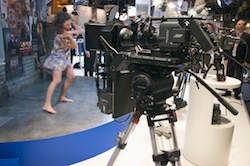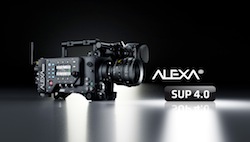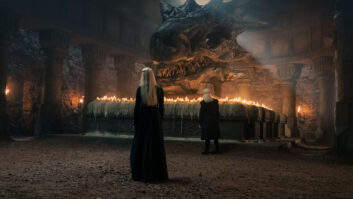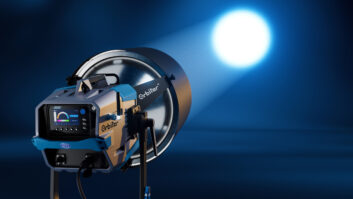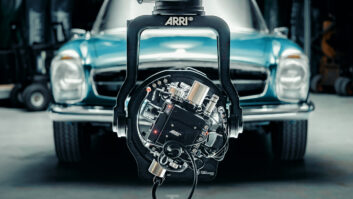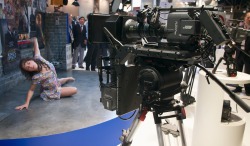
Arri has delivered production prototypes of its modular Alexa M camera to the Cameron-Pace Group. The compact M was developed with CPG for use in a new smaller 3D rig that minimises cabling and offers an optimised, streamlined 3D system, writes David Fox.
“The Arri team has been amazingly responsive to the needs of the 3D market by creating the Alexa M,” said CPG Co-Chairman James Cameron. CPG will be the exclusive distributor of the Alexa M in its Phase 1 rollout.
“The success of 3D will be based on designing technology that supports the creative process of the filmmaker; we are excited about the Alexa M towards that goal. The team at Arri has brought to the industry a great step forward toward quality 3D,” added co-chairman and CEO, Vince Pace.
The front-end of the Alexa M transmits uncompressed raw sensor data at around 18 Gbps to a back-end image processor/recorder using a hybrid fibre optic cable that can also power the head. Weighing well under 3kg, the Alexa M head has multiple mounting points and will also be useful for Steadicam or remote use.
The camera body provides the same image processing and recording options as the standard Alexa: images, sound and metadata can be recorded onto SxS Pro cards or external recorders, including uncompressed Arriraw.
The fibre means the head can be up to 1km from the body, which “allows for some unique and extremely innovative 3D camera applications. We hope CPG will take full advantage of them in the months ahead,” said Franz Kraus, managing director of Arri Munich.
The feedback Arri gets from CPG will help develop the final production version expected early 2012. Arri will also integrate elements of CPG’s 3D rig automation technology into the Alexa M.
There is also a new flagship Alexa Studio camera, which has a quiet, adjustable mirror shutter and optical viewfinder. It also has a 4:3 sensor, making it the only digital camera (besides the Arriflex D-21) to boast true anamorphic capability. Many cinematographers prefer the anamorphic look, which cannot be created in post.
Arri also has a new High Speed mode allowing Alexa and Alexa Plus cameras to run from 60 to 120 frames per second, using newly released Sony 64GB SxS Pro cards, which are about four times faster than current 32GB cards.
The 120fps feature is part of the new Alexa Software Update Packet 5.0, and has to be separately licensed. Licenses can be disabled, giving rental facilities control over which cameras have High Speed mode (4:2:2 only). The 64GB cards also allow ProRes 4444 filming at up to 60fps.
Get the look
Following its Software Update Packet 4.0, Alexas can now apply user-defined looks to customise the rendering of video images for different applications and individual preferences, enabling DoPs to preview images as they want them to appear in post and to embed the metadata that define the look in the media.
Look files are different from look-up tables, which change one colour space to another (eg from Log C to video), in being a purely creative tool used within the camera. They can be created by the colourist or the DoP, and allow monitors on set to give a better idea of the final look for each scene.
To create Alexa look files based on film lab thinking, with printer light settings, Arri has developed Look Creator, for Mac OS X, a new free application. Look Files can also be created using Pomfort’s Silverstack SET, with other developers planning similar applications. Creating looks based on Arriraw will be possible in a future software upgrade.
Alura lightweight zooms
Arri and Fujinon have doubled their range of Alura zooms with two new lightweight models: the Alura LWZ 15.5-45 and Alura LWZ 30-80, T2.8 zooms. They are designed to match the Alexa camera, and are ideal for handheld and Steadicam work, while the two original Alura Zooms, with their much wider focal ranges, are better suited to tripod and dolly setups.
“We sold twice as many as planned of the original ones, so the next obvious step is to build lightweight zooms,” said Marc Shipman-Müller, Arri product manager for cameras and lenses. “They are optimised for digital cameras, with resolution beyond 4K, and will also work with film cameras with a rotating shutter (as used on the new Alexa Studio too).” They have a 31.5mm image circle, so will cover all the digital cameras, including those with larger sensors, and will cost €16,800 each when they ship in February.
“We are the only company with a complete set of matching modern zoom and prime lenses,” he claimed.
The four Alura lenses are also compatible with the Arri Lens Data System. The optical design should ensure an evenly illuminated image on the sensor or film plane, while flares, ghosting and veiling glare are greatly reduced by Fujinon’s multi-layer Electron Beam Coating. Breathing has been minimised, as has colour fringing.
Lightweight zooms are becoming popular for 3D, as they allow easy adjustment of focal length without lens changes, rig readjustments and calibration.
Light to the Max
The new Arri M40/AS40 daylight fixture fills the gap between the 1800W M18 and the 18kW ArriMax. The M40 is a lensless system combining the advantages of a Fresnel and a PAR fixture. It is open face, very bright, and focusable from 19-60°, producing a crisp, clear shadow. By eliminating the need for spread lenses, it should speed up workflows on set and reduce the risk of lost production time because of glass breakage.
The same lamp head equipped with a PAR reflector becomes the AS40, replacing the current ArriSun 40/25. It is lighter than its predecessors, but has the same accessory diameter so that existing lenses, barn doors and scrims can be reused. The M40 and AS40 fixtures can be operated with 4kW and 2.5kW metal halide lamps.
Both implement Arri’s True Blue features, with disc brakes keeping the lamp head in place even if heavy accessories are used, while the electronics housing is spaced apart from the lamp housing to reduce temperatures and prolong component lifetimes. The units are ruggedised and IP23 certified to withstand rough handling and weather.
Other recently launched lights include the L-Series collection of focusable, LED-based lamp heads, with a true Fresnel light field for film and TV applications, and the ArriSun 18 Event light.
